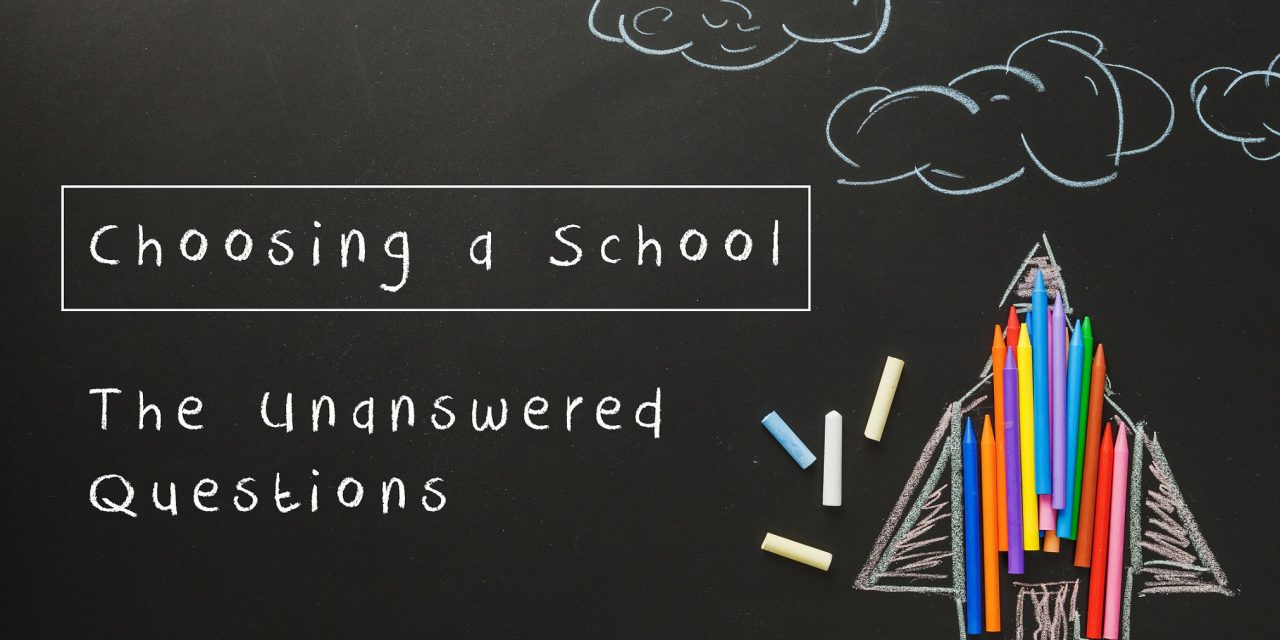Author: J. Ong
Navigating the ever-growing world of private education can be a daunting to many, especially to parents. As an educator who moved from the public system, it took me quite a while to understand what this new world has to offer. This article hopes to shed an insight from an educator’s perspective on how to choose a school and what are the considerations that should be made. In my experience, when choosing schools, parents narrow their school choices to the main three factors; cost, location and curriculum. Often, parents attend information sessions or school fairs looking for a school that packs in the best bargain. However, education and schools are a different segment altogether. Quality education does not come cheap. But, I am also not saying that by paying for an exorbitant price tag, your child is guaranteed a good education. Neither is there anything terribly wrong with the Malaysian national curriculum. Surely there are rooms for improvements and revision to areas of it – but a curriculum is only as good as it’s execution. What I am saying is that, cost of school and type of curriculum is not the only factor to consider. Matters such as the school’s value system, how they manage diversity and inclusivity as well as their propensity for growth weighs in greatly as well.
1) School’s Value System

Parents often overlook this crucial factor or get distracted by the carefully curated pictures and promotional materials shown to them. This is understandable and science proves just how visual people are. Ask the people in Coca-Cola or McDonalds, they would be happy to confirm how well their products sell through good advertising. Similarly, the demand for private education has caused a rise in marketing activities amongst the international schools in Malaysia. Individual schools not wanting to lose out on their share, compete either by price war or by showcasing the best of what they have to offer. Having said that, in this article we are operating under the assumption that most international schools in Malaysia runs the British Curriculum and the content is similar across the board.
It is likely that most schools now employ a team to handle their marketing and sales, with staff focused on bringing in the student numbers. To them, the sales target is their only priority. Therefore, the strategy employed here is to highlight the benefits of the school, such as campus size, facilities, accreditation and extracurricular activities. What they often try to skip, or miss is emphasis on the value system of the school and the working application of the ethos/values/mission/vision they claim to have. Why is this so? The answer is simple – because it has never been asked and it is hard to answer if you are not an educator.
Hence, I always encourage parents to schedule an appointment with the principal, team leaders, year leaders, and potential homeroom teachers. When you meet them, do not be shy to ask the hard questions and demand for a genuine answer. I am not asking you as a parent to be unreasonable or incredibly difficult, the last thing any school need is a parent wanting to walk through the entire year’s lesson plan or nit picking on a school’s policy. What we do welcome are question such as: “When you say that you practice excellence in education? What are your priorities?”, “How do you as a school leader model excellence to your team? Or “How does a teacher showcase integrity?’, “What does your school mean by providing opportunities to be a global citizen?”
A large part of what educators are supposed to do in school is to model good behaviours or exemplar actions. If the school is unable to model such systems/actions at an operational level i.e. leaders and teachers. Often you would struggle to see it translated into students’ outcomes. A good point to note is that, high performing schools’ is often anchored by both strong leadership and good actions shaped by a strong school culture or value system.
2) Diversity and Inclusivity

Another factor often overlooked, is the way the school caters for diversity and inclusion. The way the school manages classroom practices to cater for inclusivity is important because an inclusive classroom will allow for the students to feel supported intellectually and academically and provides a sense of belonging in the classroom (Yale, 2018). On top of that, research by the The Civil Rights Project at UCLA found that diversity is the key to preparing students for an increasingly global economy. Not to mention, classrooms that provides for different intellectual abilities benefit all students. (Frakenber, et al., 2003). This ensures that the student feels safe, welcomed and happy in school. A very important part of a student’s learning experience.
This is especially important as most international schools in Malaysia receive a significant number of international/foreign students as well as local students who come from different social-cultural backgrounds. Now, parents are often told that the curriculum itself provides for diversity i.e. an international curriculum offers perspectives from across the world and students will be exposed to different cultures through their history or geography lesson. This is not entirely true and there should only be partial reliance on the curriculum to provide for this.
Schools that model’s diversity will feature aspects such an emphasis on using a range of teaching materials that includes different cultures, genders and social classes. The school will strive to actively connect or engage with parents and their community. On top of that, having a multi-disciplinary, ethnic and gendered teaching faculty and leadership team helps set the right tone for it. It is more likely that a homogeneous group of teachers could maybe overlook certain cultural norms.
Creating an inclusive classroom is a challenge but a school promoting this should allow for students to be placed in age-appropriate classes, give them access to high-quality instruction, provide interventions and support activities that enable them to meet success in the core curriculum. Successful inclusive education happens primarily through accepting, understanding, and attending to student differences and diversity, which can include physical, cognitive, academic, social, and emotional needs (McManis, 2017). This means that curriculum planning and execution should be focused on the student’s needs rather than the goals set by standardized curriculums or high-stake tests. Inclusivity also encompasses awareness with regards to mental health and emotional wellbeing of their students. This is to prepare for the unfortunate rising rate of depression, suicide or emotional trauma that affects the students. Do look out for schools which feature a strong counselling department, support groups or certified therapist. It signals that the school is aware of the current issues and is striving to assist in such matters.
When it comes to diversity and inclusivity, questions to ask may include “Will my child feel safe and supported in class because he/she is an international student?” “What are the ongoing steps the school takes to ensure this happens?” “What are the learning materials that are being used to feature different women or races?” “Are there opportunities for students or parents to network with one another?” and most importantly “What are the resources allocated for both academic and non-academic support for my child?”
3) Culture of Excellence & Propensity for Growth

This often comes as a surprise to many but often ranked most important – What is the culture of excellence and growth practiced in the school? This is particularly important as you would want to ensure that the school prioritises training and professional development to ensure that their teachers are upskilled and continuously improve at what they do. This is not a foreign concept and commonly practiced in corporate settings. The top corporate companies spend thousands of dollars a year investing in the professional development and growth of their staff. They understand that for an organization to thrive in the 21st century, a strong talent management program must be designed to not only attract but retain the best people in the organization. Which boils down to the fact that, to get good teachers – a school must have a plan. One that will bring in the best talent in the market and then a system that will keep them in the school.
It was shown in the 2007 McKinsey report on best performing school systems that schools or systems who ranked the highest in the PISA examinations, often focus on the improving their teachers and strengthening their leadership (McKinsey & Company, 2007). Therefore, a good school would always prioritize its investment in the professional development of their teachers and leaders. Teachers are the classroom leaders and ultimately their mindset/actions go on to affect the student’s mindsets/actions and then outcomes. Therefore, if a school is actively allocating resources to continuously grow and aim for excellence from their staff, it is a logical conclusion, that the students will directly benefit from it.
Apart from staff growth, there should also be consideration for the student’s holistic growth. School policies should aim to achieve excellence and growth in non-academic aspects of schooling to compliment academic excellence. A good school will be able to provide students with access to non-academic items such as: community engagement and social entrepreneurship activities, networking opportunities with industry mentors, exposure to different types of learning environments, participation in state or national level events and a range of sporting/physical activities.
Therefore, spend some time asking the school representatives about the teaching staff and leadership. I would say, speak to the teachers and get them to walk you through their professional development journey with the school. Ask them, what they look for in their own growth and why did they choose to teach in the school. Check to see if they are well supported or if they know of the support systems that will compliment your child’s academic, behaviour and emotional growth.
The final say?
Choosing a school is a complex exercise and if done right, quite a tedious one. Apart from trying to understand what each curriculum has to offer or which price point suits you better, there are factors as listed above to consider as well. It is my hope that this reading would have given you an insight view of how we, as educators hope parents would choose a school. We will recommend a school that fits your personal goals/vision of education, one that seeks to include and not exclude, one that has a great culture of excellence and growth for teachers and students. One that strives to have learning strategies designed with the students at the core.
And lastly, I also do hope that parents choose a school that is properly accredited and licensed by the Ministry of Education and examination accreditation authorities. It is disheartening to see how some parents’ risk their child’s education by placing them in unauthorized substitute educational centres. These places normally promise a heavily discounted tuition fee and an untimely acceleration into higher year levels grades. Their policy goes not only against the very ethos of schooling and counter intuitive to the very notion of schooling. This is all done at the at the detriment of the child. The question is, what are parents really looking for in a school?
Read more:








